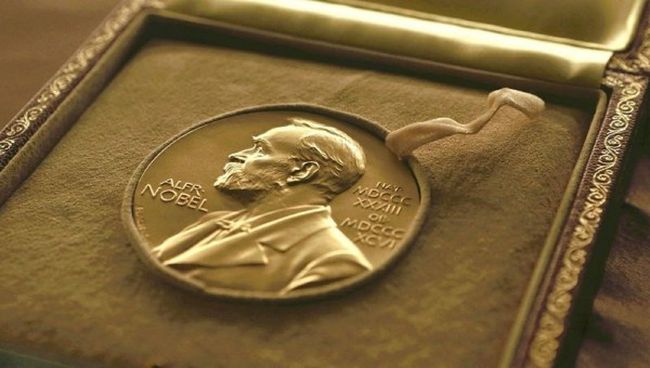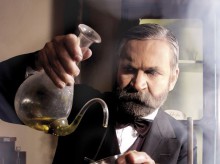Great scientific research is great in that you can talk about them endlessly: they have a long history and almost never have a definite end. Scientific competitions are attractive because the gist of a great research project needs to be squeezed into several sentences. As a rule, no one succeeds in it, thus it gives rise to argument, discussion, and interest in science as such.
October 2 opened a new Nobel week, when the Nobel Committee announces the names of the laureates of the year’s most prestigious award. First the laureates in physiology and medicine were made public, on October 3 the names of the laureates in physics, and on October 4, in chemistry. On October 5 and 6 winners in literature will be named, as well as the winner of the Nobel Peace Prize. The Nobel Memorial Prize in Economic Sciences, established by the Swedish National Bank in 1969, is to be awarded on October 9.
Some conclusions in the sphere of natural sciences could be drawn today.
GRAVITATIONAL WAVES AS A WINDOW INTO THE UNIVERSE
The 2017 Nobel Prize in Physics was divided between Americans Rainer Weiss and (jointly) Kip S. Thorne and Barry C. Barish, for the design of gravitational waves detector and experimental proof of their existence.
The Universe has been predominantly explored through the study of electromagnetic waves. This method has its own limitations associated with the peculiarities of how they travel. To extend our opportunities, scientists have long been trying to look into other forms of radiation, namely neutrino and gravitational waves. This is where the Nobels for physics have been awarded over the recent years: for the study of these “windows into the world.”
The existence of gravitational waves was predicted by Albert Einstein back in 1915, based on the general relativity theory. These waves result from interaction of objects with huge masses, which creates disturbances in space-time. These ripples travel in all directions at the speed of light. Einstein himself believed that a gravitational wave has such a negligible effect on matter that it cannot be recorded by technical means.

The very effect of a gravitational wave is quite tricky to capture, but its indirect effects could be registered. In 1974, American astrophysicists Joseph Taylor and Russell Hulse measured a double pulsar PSR B1913+16 and proved that the deviation of its pulsation period from the estimate could be accounted for by a loss of energy “carried away” by a gravitational wave. This discovery earned them the Nobel Prize in Physics in 1993.
And finally, on September 14, 2015, the Laser Interferometer Gravitational-Wave Observatory (LIGO) first recorded a gravitational wave directly (Den described this event as a revolution in physics).
The checking of the results of the discovery took about several months, and more time was necessary to let its importance sink in. Apart from the existence of gravitational waves, the existence of black holes with masses up to 20-60 times that of the Sun was also proved, just like the possibility for their merging (which sent the recorded waves throughout the space).
The instrumental aspect of the discovery seems totally incredible. Despite the huge energy of a gravitational wave, its amplitude is very small. To register waves with such amplitude, a special methodology was developed by the new laureates.
With the help of this methodology and LIGO and VIRGO instruments, four gravitational waves have been recorded as of today. The most recent was sent by an explosion of a neutron star.
The Nobel Prize logically crowned the 25-year-long effort of the designer team who created the LIGO detector and thus completed the 100-year-long Odyssey of Einstein’s idea of gravitational waves.
THE TECHNOLOGY OF DISCOVERY: BIOMOLECULAR VISUALIZATION AND RESOLUTION REVOLUTION
The 2017 Nobel Prize in Chemistry was awarded to Professor Jacques Dubochet (the University of Lausanne, Switzerland), Professor Joachim Frank (Columbia University, New York, US), and Richard Henderson, a researcher from Cambridge University, UK, “for developing cryo-electron microscopy for the high-resolution structure determination of biomolecules in solution.”
The methods of cryo-electron microscopy have played a crucial role in the research of previous years’ Nobel laureates. For example, these methods underlay the study of the structure of the ribosome, which earned the authors the prize in chemistry in 2009.
Cryo-electron microscopy has over the recent years become a major cutting-edge research method in cellular and molecular biology and medicine. In the last decades it has enabled the study of molecules of biological origin in solutions with other indicators of resolution, which has considerably expanded the range of action for biologists and biochemists.
Cryo-electron microscopy allows the study of samples instantly frozen at the temperature of liquid nitrogen. The samples do not need to be colored or otherwise processed, which means that the structure of the matter remains unchanged. According to the Nobel Committee, this method “has moved biochemistry into a new era,” one of totally innovative instruments of visualization and resolution revolution in machinery. This revolutionized discoveries in biochemistry, says the Nobel Committee.
HEALTH AS A SYNCHRONIZED ENTITY OF VITAL PROCESSES
American scholars Jeffrey C. Hall, Michael Rosbash, and Michael W. Young became Nobel laureates in physiology and medicine. The award became a recognition of their study of circadian rhythms, or cyclical oscillations in the intensity of a range of biological processes in our bodies during the 24-hour cycle. The Nobel Committee remarks that the scientists were able to “peek inside our biological clock and elucidate its inner workings.”
The prize crowned the research which lasted more than 30 years. Back in 1984 the scientists identified a gene associated with the circadian rhythm control in Drosophila (known as “period gene”). It codes a special protein (PER-protein) which accumulates in cells overnight and is gradually destroyed in daytime. This cycle lasts around 24 hours. Further, Young identified two more genes associated with circadian oscillations, dubbed “timeless gene” and “doubletime gene.” Both code proteins essential for the regulation of the circadian cycle.
Circadian rhythms are inherent to myriads of living beings, from cyanobacteria and fungi to plants to animals. In humans an example can be seen in the daily sleep-wake cycle. Humans are known to be able to keep up the usual sleep pattern even at the absence of external stimuli. Also circadian rhythms are associated with feeding behaviour, body temperature, production of various hormones, and changes of blood pressure.
This year’s winners showed in their research how the “inner clock” of living cells works, and how its functioning is related to controlling such functions as sleep, hormone release, body temperature, and metabolism. They were able to reveal its comprehensive mechanism. According to the Nobel Committee, the research has shown the existence of association between a well-functioning organism’s circadian rhythm and human health.
It would be probably just to say that the 2017 Nobel in natural sciences has brought no sensations. This year’s logic of awards is quite consistent with the conventional methodology of science. Firstly, persistent systematic work, based in an interesting and well-grounded idea, brings forth important results and will be rewarded. Secondly, the development of methods and tools of research has been of particular importance and remains primary goal. And finally, the role of cooperation and scientific interaction is crucial for resulting success.
One might well say that today we observe further development of the trend, first clearly marked three years ago, towards definite technological and social bias of prize-winning research.
Such a bias is probably welcome. If something has to be stable in our floating world, let it be the methodology of scientific cognition.

P.S. “The 2017 Nobel Prize in literature is awarded to Kazuo Ishiguro who, in novels of great emotional force, has uncovered the abyss beneath our illusory sense of connection with the world,” reads the citation of the Swedish Academy. Ishiguro holds the Whitbread Prize for An Artist of the Floating World and the Booker Prize for The Remains of the Day. Besides, his other works, When We Were Orphans and Never Let me Go have been nominated for Booker. His name is included in The Time’s list of the 100 best novels of all time. Never Let Me Go (translated into Ukrainian by Sofia Andrukhovych) was recently published by The Old Lion publishing house.








